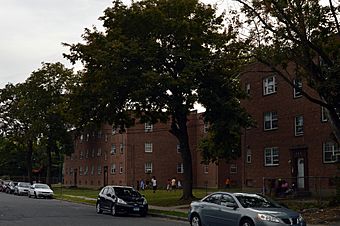Laurel and Marshall Streets District facts for kids
Quick facts for kids |
|
|
Laurel and Marshall Streets District
|
|
 |
|
| Location | Laurel, Marshall, and Case Sts., and Farmington Ave., Hartford, Connecticut |
|---|---|
| Area | 23 acres (9.3 ha) |
| Architect | Scoville, Albert W. |
| Architectural style | Colonial Revival, Queen Anne, Shingle Style |
| MPS | Asylum Hill MRA |
| NRHP reference No. | 79002673 |
| Added to NRHP | November 29, 1979 |
The Laurel and Marshall Streets District is a special area in Hartford, Connecticut. It's like a time capsule! This district is full of homes built a long time ago. Most of these houses were built between the late 1800s and early 1900s. You can find this historic area in the Asylum Hill neighborhood.
Many of the homes here show off a beautiful style called Queen Anne. Because of its unique history and architecture, this district was added to the National Register of Historic Places in 1979. This means it's an important place to protect!
A Look Back: History of the District
Long ago, the land where Laurel and Marshall Streets now stand was mostly farmland. It belonged to people like Marshall Jewell and James Niles. This was in the mid-1800s.
After Marshall Jewell passed away in 1883, the land began to change. Builders started to create new streets and homes. The first houses were built north of Farmington Avenue. These were mostly wooden homes along Laurel and Marshall Streets.
Later, around the year 1900, the area between Farmington Avenue and Case Street was developed. Over time, some of these original houses have been replaced. Newer apartment buildings stand where some old homes once were.
What You Can See Today
The historic district stretches from Niles Street in the north to Case Street in the south. It includes most of the old buildings on Laurel and Marshall Streets. You can also find a few historic rowhouses on Imlay Street to the east.
Most of the old houses are made of wood. They have a special look called Queen Anne. You might see cool features like small towers called turrets. Many homes also have fancy cut shingles and pretty latticework on their porches.
There are also a few brick houses in the district. Some buildings were designed for more than one family. While some old homes are gone, many beautiful historic buildings still stand. They help us remember what Hartford was like over a hundred years ago!



